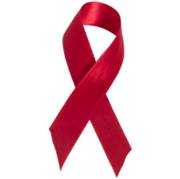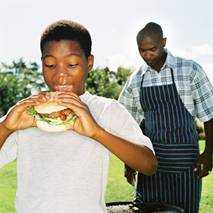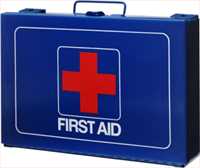 ShareCompartir
ShareCompartir
Story Ideas - 2010
Feb
You've kept to your resolutions of maintaining a healthy weight and eating right. It's time to start looking at other aspects of your health that could be improved as well! February is American Heart Month as well as Black History Month; we invite you to take a look at our story ideas as well as revisit the recently update the African-American Media Resources page.

A Pinch of Salt
You can bet Mary Poppins wouldn't have recommended a spoonful of salt to help the medicine go down, but research shows that most Americans consume too much salt. Most of the sodium we eat comes from packaged, processed, store-bought and restaurants foods. Of that, only about 5% comes from salt added during cooking and about 6% comes from being added at the table. The salt in our foods and table salt is made up of sodium and chloride, and too much sodium can increase blood pressure and consequently your risk for a heart attack or stroke.

Burned
Saturday night your family is cozy by the fire, prepared for a good movie and some quality time together. Your son asks to add another log to the fire and you say yes. He doesn't get his hand out quick enough and ends up with a burn on the side of his hand. Every day, 435 children ages 0 to 19 are treated in emergency rooms for burn-related injuries and two children die as a result of being burned. Help prevent this happening and educate your readers.

A Woman's World
Although heart disease is sometimes thought of as a "man's disease," it is the leading cause of death for women in the United States, who account for nearly 50% of all heart disease deaths. In 2006, heart disease was the cause of death in nearly 316,000 females. Heart disease is often perceived as an "older woman's disease," and it is the leading cause of death among women aged 65 years and older. However, heart disease is the third leading cause of death among women aged 25-44 years and the second leading cause of death among women aged 45-64 years. See the links below and remember many cases of heart disease can be prevented!

Every 25 Seconds
About every 25 seconds, an American will have a coronary event and about one every minute will die from one. Heart disease is the leading cause of death in the United States and in 2009, an estimated 785,000 Americans had a new coronary attack, and about 470,000 will have a recurrent attack.
High cholesterol, high blood pressure, obesity, diabetes, tobacco use, and secondhand smoke are risk factors associated with heart disease. Making your readers aware that what they eat, how physically active they are as well as if they smoke and drink can have an impact on their chances of having a heart attack might help save their lives.
- Statistics on the burden of heart disease in the United States (including ethnicity, geography and by risk factors)
- National Heart Disease Mortality Maps
- Risk factors for developing heart disease
- Conditions (blood cholesterol levels, high blood pressure, diabetes)
- Behavior
- Heredity
Mar
Spring is right around the corner, the days are getting longer and the weather is getting warmer. In Ancient Rome, March used to be the start of the year, so it's time to reaffirm those resolutions and pave the way to a healthier you.

Take Five
Take five and rack up the savings! Americans are always looking for ways to save, and taking steps to improve your health and that of your family can help you save money, stress and time. Being healthy and safe takes commitment, but it doesn't have to be time-consuming, painful, or boring. Most things are so simple and take so little time, that you'll wonder why you've been avoiding them. You can get big rewards just by taking small steps to prevent illness and injury. You won't necessarily "see" the rewards, such as the extra pounds you didn't gain, the high blood pressure you didn't get, the emergency room visit you avoided. Give your readers some good advice and see how they save!

Screen for Life
Of cancers affecting both men and women, colorectal cancer (cancer of the colon and rectum) is the second leading cancer killer in the United States. Between the ages of 50 and 60, the chance of getting colorectal cancer within the next 10 years doubles. Colorectal cancer can often be prevented through regular colorectal cancer screening tests that can find precancerous polyps so they can be removed before they have a chance to turn into cancer. Despite efforts to encourage screening, an estimated 40% of adults aged 50 or older—the age group at greatest risk of developing colorectal cancer—have not been screened appropriately. Make sure your readers take advantage of the screenings offered and reduce their health risks.

Get in, Get Out, and How to Stay Healthy in Between
Imagine a scenario like the following: your mother starts having chest pain, your son breaks his ankle during football practice or your spouse is in a car accident. You rush to the hospital and you are told that your loved one is going to recover, but will spend some time in the hospital. However, extra time in the hospital can also put patients at risk for a healthcare-associated infection (HAI), such as a bloodstream, surgical site, or urinary tract infection. Every day, patients get infections in healthcare facilities while they are being treated for something else. In American hospitals alone, healthcare-associated infections account for an estimated 1.7 million infections and 99,000 associated deaths each year. Help your readers stay healthier in the hospital with these tips.

World Kidney Day
March 11 is World Kidney Day, an event intended to raise awareness of the importance of prevention and early detection of kidney disease. In the United States, kidney disease is the ninth leading cause of death, and diabetes is the leading cause of chronic kidney disease. If current trends continue, 1 in 3 Americans will develop diabetes sometime in their lifetime, and those with diabetes will lose, on average, 10–15 years of life. People with type 2 diabetes, the most common form of diabetes among adults, have high rates of cholesterol and triglyceride abnormalities, obesity, and high blood pressure, all of which are major contributors to higher rates of cardiovascular disease. Don't let your readers miss another day!

Sisters
HIV and AIDS were originally thought to affect mostly gay men. However, women have always been affected too. And even though more men than women have HIV, women are catching up. In fact, if new HIV infections continue at their current rate worldwide, women with HIV may soon outnumber men with HIV. In 2007, more than a quarter of diagnoses of HIV infection in the United States were among women and girls aged 13 years and older. The numbers are unsettling: More than 278,000 women and adolescent girls in this country are living with HIV; and almost 94,000 American women and girls with AIDS have died since the epidemic began. Keep your female readers aware of the risks.
Jun
School is ending and summer is finally here. It's time to take a walk, go for a swim and enjoy some outdoor activities. Remind readers that being safe is the key to having fun.

Don't get sidelined at FIFA World Cup
Traveling to South Africa to cheer on your favorite soccer team at the FIFA World Cup this summer? Don't let the trip leave you sidelined! Enjoy your time in South Africa by playing it safe and following some safety tips from CDC.
- Stay Healthy During the World Cup in South Africa
- World Cup 2010 in South Africa
- World Cup 2010 in South Africa Recommendations and Information for the General Public
- CDC Urges Awareness of Measles in South Africa
- Learn more about packing a travelers' health kit on the CDC Travelers' Health website.
- Health: What You Need to Know in Advance of Travel

"Take the Test, Take Control"
Get ready. June 27 is National HIV Testing Day. Getting tested for HIV is easy and the first step to improving your health and the health of your partners. Every 9 ½ minutes another person in the U.S. becomes infected with HIV, and more than 200,000 Americans are living with HIV but don't know it. Recent data indicate that African Americans and gay and bisexual men of all races continue to be most severely affected. Early diagnosis is critical; too many people are getting tested and diagnosed at advanced stages of disease, when treatments are less effective and after years of lost opportunities to prevent transmission. More information can be found at the National Center for HIV/AIDS, Viral Hepatitis, STD, and TB Prevention Newsroom.

Say "Ah"
Cooking out this summer? Who doesn't love a big juicy burger? Cooking to a safe internal temperature of 160°F will ensure that your burger is perfectly safe. However, it's important to be mindful of foodborne illness or "food poisoning" when preparing summertime meals because disease–causing bacteria are often more prevalent in warmer weather. Many different agents of disease or pathogens like E. coli and Salmonella can contaminate foods or beverages.
Each year millions of people become sick from foodborne disease in the United States. The great majority of these illnesses are mild and cause symptoms for only a day or two. But some foodborne illnesses are more serious – every year thousands of people are hospitalized and some actually die from complications associated with foodborne diseases. The most severe illnesses tend to occur in the very old, the very young, those who already have an illness that reduces their immune system function, and in healthy people exposed to a very high dose of disease – causing bacteria. Foodborne illnesses that cause vomiting and diarrhea can be treated by replacing lost fluids and electrolytes. If you experience a diarrheal illness and it's accompanied by high fever, blood in the stool, prolonged vomiting and signs of dehydration please consult a health care provider.
For further information about food safety and foodborne disease please look at the sites below:
Jul
Fourth of July celebrations and fireworks, camping with friends, family reunions and cookouts… these are just a few of the many things to do this July! So while you're enjoying an exciting summer vacation or having fun in the sun, we encourage you to be safe this summer, wherever you are, and take a look at our story ideas for tips on summer safety.

Fireworks Safety
Firecrackers and sparklers, lots of BBQ and grilled hamburgers and hot dogs are some of the ways we celebrate the holidays. Cautions about fireworks are always important, especially around 4th of July celebrations and cookouts when most fireworks injuries occur. Many communities have fireworks displays that are handled by professionals. Be safe. Avoid the common fireworks injuries; leave the fireworks to the professionals.

Family Reunion Food and Fun Tips
Family reunions are a time of enjoyment and laughter with all of your loved ones. It's also a great time to instill healthy living activities, ideas, and traditions that your family can continue for years to come. CDC suggests family reunion health and safety tips to live by this summer. A family reunion is also a good opportunity to talk about your family's medical history.

S'more Happy Campers!
We've all heard the phrase "not a happy camper," but with these tips from CDC, you can be a happy, healthy, and safe camper. Camping is a great way to get friends and family together and enjoy the great outdoors. Take a few minutes before your trip and review some camping and hiking tips to ensure a fun and healthy trip.
Aug

Care for the caregivers
Caregivers are people who provide assistance to someone who is, to some degree, incapacitated and needs help. Typically, recipients of care have a chronic illness or disabling condition, and need ongoing assistance with everyday tasks in order to function on a daily basis. As the number of older American rises, so does the number of needed caregivers. Caregiving exacts a tremendous toll on caregivers’ health and well-being, and accounts for significant costs to families and society as well.
Although challenging, caregiving is generally undertaken voluntarily and most people indicate that they found it personally fulfilling (Family Caregiver Alliance, 2006). Most caregivers can identify positive aspects of providing care, which can assist with coping and lower perceived burden. However, some caregivers may face stress, burden, depression, and negative health effects from their duties. Many caregivers do not adhere to recommendations to follow a healthy diet and exercise program and tend to avoid preventive care for themselves. If your readers or viewers have a family member who needs long–term care, share this RE-AIM framework, “Assuring Healthy Caregivers”, with them. You can also visit the links below to learn more about caregiving:
Related Links

Lesson 1: Safety First
55 million students will be returning to classrooms across the United States this fall. If this includes your children, there are things you can do to help them. From an early age, safety awareness is key. Whether it is by car, bus, bike, or walking, the minute a child leaves home, safety becomes a concern. Children need to use seatbelts, look both ways before crossing a street, wear helmets when appropriate, take steps to form respectful relationships, and know how to avoid and reduce conflicts. Safety is also important at school, both in the classroom and during activities such as sports. When parents and educators work together, safety becomes a lifesaving priority that benefits the entire community. In honor of August, National Immunization Awareness Month, CDC would like to remind parents to update their children's vaccinations before school starts. Doing so will protect your child and others from various illnesses.
Related links

Drive with Caution
Motor vehicles have made travel easier and promoted economic and social development in many countries. Because of the widely-known benefits of motor vehicles, it may be easy to forget they can be a danger to drivers and pedestrians alike. Globally, every year, about 1.3 million people are killed in motor vehicle crashes and 20-50 million more are seriously injured. By 2020, motor vehicle crashes are expected to become the third most serious threat to human health in the world, making safe driving one of the foremost priorities in public health.
In the U.S., motor vehicle crashes are the leading cause of death for teens, accounting for more than one in three deaths in this age group. In 2008, nine teens ages 16 to 19 died every day from motor vehicle injuries. Per mile driven, teen drivers ages 16 to 19 are four times more likely than older drivers to crash. Fortunately, teen motor vehicle crashes are preventable, and proven strategies can improve the safety of young drivers on the road.
Texting while driving, as well as distracted driving, is becoming a well known problem among drivers of all ages. In 2008, nearly 6,000 people of all ages died in crashes involving a distracted driver and more than 500,000 were injured. Because of these surprising numbers, the Department of Transportation recently launched the national campaign "Put it Down" to encourage the public to end distracted driving.
Related links

Prostate Cancer
Be Aware. Be Prepared.
Prostate cancer is the most commonly diagnosed cancer in the United States and the second leading cause of cancer death. African American men, men above the age of 50, and men who have someone in their family who has had prostate cancer are at a higher risk for having the disease. Some medical experts believe all men should be offered regular screening tests for prostate cancer. Other medical experts do not. While there is uncertainty about the benefit of screening, the need for more men to be aware of the risk is undeniable. In 2006, 203,415 men were diagnosed with prostate cancer, and 28,372 men died from it.
CDC provides a prostate cancer screening decision guide [369 KB] that can be helpful to someone who is weighing the decision of whether to get screened by a doctor or not. The symptoms of prostate cancer can go undetected due to the fact that some men do not show symptoms, but if present the symptoms to notice are:
- Difficulty in starting urination.
- Weak, or interrupted flow of urine.
- Frequent urination, especially at night.
- Difficulty in emptying the bladder completely.
- Pain or burning during urination.
- Blood in the urine or semen.
- Pain in the back, hips, or pelvis that doesn't go away.
- Painful ejaculation.
Related links
Sep

Ear infections – will antibiotics help?
All members of your family can be affected by ear infections and when you or your children are suffering, the answer might be antibiotics. But, when the ear infection is caused by a virus, taking antibiotics may do more harm than good. Your readers need to know that each time they take an antibiotic unnecessarily, bacteria that normally live in their bodies are encouraged to become antibiotic-resistant. This means that the next time they get sick they are more likely to become ill with an antibiotic-resistant infection.
There are three main types of ear infections, which have different causes and treatments: acute otitis media, otitis media with effusion, and otitis externa. Your healthcare provider can determine what kind of ear infection is present and if treatment is needed. Parents are warned that if your child is younger than three months old, it is important to call your doctor immediately. Signs that your child may have an ear infection are pulling at the ears, excessive crying, fluid draining from their ears and fever.
To prevent ear infections, avoid smoking or exposure to second hand smoke. Be sure to keep you and your child up to date with recommended immunizations and breastfeed your baby for 12 months or more if possible. Healthcare providers may decide to wait a couple of days before prescribing antibiotics since you or your child may get better without them. Rest, over-the-counter medicines and self-care methods may relieve the symptoms of ear infections without the misuse of antibiotics. But remember, many over-the-counter products are not recommended for young children.
Related links:

National Cholesterol Education Month
What has no symptoms to notice, and yet puts more than 35 million people at high risk for heart disease? The answer is cholesterol. Cholesterol is a waxy, fat-like substance found in your body and many foods. Your body needs cholesterol to function normally but too much cholesterol can build up in your arteries. After a while, these deposits narrow your arteries, putting you at risk for heart disease and stroke. High cholesterol usually doesn't have any symptoms. As a result, many people do not know that their cholesterol levels are too high. However, doctors can do a simple blood test to check your cholesterol. High cholesterol can be controlled through lifestyle changes or if it is not enough, through medications. Explain to your readers that it is important to check their cholesterol levels. High cholesterol is a major risk factor for heart disease, the leading cause of death in the United States.
This September, tell your readers how to celebrate National Cholesterol Education Month by lowering their cholesterol:
- Low-fat and high-fiber food (Eat more fresh fruits, fresh vegetables, and whole grains).
- For adults, get at least 2 hours and 30 minutes of moderate or 1 hour and 15 minutes of vigorous physical activity a week. For those aged 6- 17, get 1 hour or more of physical activity each day.
- Maintain a healthy weight.
- Don't smoke or quit if you do smoke.
Related links

Emergency Preparedness
Though we may not be able to know exactly when an emergency or natural disaster will take place, we can still be prepared. Early preparation is especially important for people with chronic health condition. In an emergency situation or natural disaster, access to health care providers can be limited. National Preparedness Month is aimed to encourage people to know what to do during an emergency or a disaster, such as a flood or fire. To make sure that you are as prepared as possible the CDC suggests some tools you may want to have in the event of an emergency.
Related links

Watch Your Step
Preventing Falls in Older Adults
Every year, one in three adults age 65 and older falls. Twenty to 30 percent of those who fall suffer moderate to severe injuries that can threaten their ability to live healthy, independent lives. Your readers should know what simple steps they can take to lower these risks. One of the very best ways to reduce the risk of falling is by exercising regularly in order to strengthen legs and help improve balance, but it's important to talk to a health care provider before starting an exercise routine. Second, readers should be sure to tell their health care provider all the medications they are taking, to be sure there are no drug side effects or interactions that could affect balance. Third, it's important to have annual eye examinations and to update prescriptions to improve vision as much as possible. Finally, other steps people can take around the house to reduce their chances of falling include removing trip hazards, adding brighter lights, putting non-stick mats on shower and bathtub floors, installing grab bars next to and inside the shower or tub, and adding railings on both sides of the stairs (indoor and outdoor).
Related links
Oct

Breast Cancer Awareness Month
Not counting some kinds of skin cancer, breast cancer is the most common cancer in women in the United States. It is the most common cause of death from cancer among Hispanic women, and the second most common cause of death from cancer among white, black, Asian/Pacific Islander, and American Indian/Alaska Native women.
A mammogram is an X-ray of the breast. Mammograms are the best way to find breast cancer early when it is easier to treat and before it is big enough to feel or cause symptoms. Having regular mammograms can lower the risk of dying from breast cancer. Women between the ages of 40 and 49 should talk to their doctor about when to start getting mammograms. Women who are 50 or older should get a screening mammogram every two years.
CDC's National Breast and Cervical Cancer Early Detection Program (NBCCEDP) offers free or low-cost mammograms to women who qualify.
Related links

National Lead Poisoning Prevention Week 2010
Today, lead poisoning is considered the most preventable environmental disease among young children, yet approximately 250,000 U.S. children aged 1-5 years have elevated blood-lead levels. Because lead poisoning often occurs with no obvious symptoms, it frequently goes unrecognized. A simple blood test can prevent permanent damage that will last a lifetime.
National Lead Poisoning Prevention Week is October 24-30, 2010. Educate readers by raising awareness about childhood lead poisoning, stressing the importance of testing the home and screening young children for lead, and urging people to take steps to reduce lead exposure.
Related links

School Nutrition
Children in the United States are becoming increasingly overweight and obese, and most do not meet recommendations for a healthy diet. The school environment is one of several settings that can influence children's food choices and eating habits. By ensuring that only nutritious food options are available, schools can model healthy eating behaviors and help improve dietetic intake. Tell your readers what they can do to engage in efforts to improve the school nutrition environment by supporting strong state and district school nutrition standards, reviewing the district's school wellness policy, examining the foods and beverages that are available to students and educating students about nutrition and offering healthy foods and beverages.
The following links provide more information about school nutrition and getting involved to help improve your child's school nutrition:

Achieve Freedom! How to Quit Smoking
Did you know the benefits to quitting smoking begin just 20 minutes after your last cigarette? One out of every five deaths in the United States is caused by tobacco use. On average, adults who smoke die 14 years earlier than nonsmokers. Help your readers understand that by quitting smoking, they lower their risk for cancer, heart disease, stroke and respiratory diseases. Click on the following links for advice on quitting smoking for your readers.
Nov

Healthy Holidays
Family, fun…and FOOD! It's what the holidays are all about, right? But that doesn't mean you have to pack on the holiday pounds. Balance the calories you consume with the calories you burn, and avoid any holiday weight gain. Here are some ways to help you do just that:
Take the Extra Calories Out of Cooking!
- If you're heading out to a party—holiday, birthday or any sort—eat a light, healthy snack before you go. Broth-based soups, cereal with skim milk, or just plain fruit are all good options! This will help curb your hunger and decrease your visits to the buffet table.
- Modify recipes to reduce the amount of fat and calories. For example, when making lasagna, use part-skim ricotta cheese instead of whole-milk ricotta cheese. Substitute shredded vegetables, such as carrots, zucchini, and spinach for some of the ground meat in lasagna.
- Bring a low-fat, holiday dish to the party. Need some suggestions? Visit CDC's Healthy Recipes site for details.
- When eating or snacking in front of the TV, put the amount that you plan to eat into a bowl or container instead of eating straight from the package. It's easy to overeat when your attention is focused on something else.
- Choose water, diet, or low-calorie beverages instead of sugar-sweetened beverages.
- Limit your alcoholic beverage intake. Alcoholic drinks can have many calories, especially holiday favorites like eggnog. Cut or limit your alcohol calories by drinking more water.
Get Active, Healthy and Happy!
- Make a goal with a friend to meet the new Physical Activity Guidelines! Visit CDC's Physical Activity for Everyone site for details.
- Sign up for a 5K walk or run to keep your mind focused on physical activity goals. Maintain your physical activity during the holidays— better yet, try and get more active! It will make those New Year's resolutions even easier to attain.
- Find fun, creative ways your friends and family can spend time being active instead of eating. Be sure and spend time together that doesn't revolve around a meal.
Visit CDC's Healthy Weight for more information.

Protecting Internationally Adopted Children from Lead Poisoning
Prospective parents adopting a child from overseas need information to safeguard the health of the child from lead poisoning, which can cause several health problems, including brain damage. The risk for lead exposure is much higher in many countries from which children are adopted than in the United States. Each country sets its own policies or regulations for environmental exposures, including lead, and some countries have stronger regulations than others. CDC has information on this topic for adoptive parents and health care providers.
November is National Adoption Month. The U.S. Department of State's Office of Children's Issues shows that from October 1, 2008, to September 30, 2009, a total of 12,753 internationally adopted children immigrated to the United States. The largest numbers of these children were originally from Ethiopia, mainland China, South Korea, and Russia.
Foreign-born adopted children tend to have higher levels of lead in their blood than children born in the United States. Readers can learn more about how internationally adopted children may have been exposed to lead before they came to the United States, and what they can do take to get the child proper diagnostic screenings and follow-up care if needed.
Important points to emphasize
Internationally adopted children can be exposed to lead from a number of sources including, cooking utensils and cosmetics, leaded gasoline, exhaust, drinking water from metal pipes or storage containers, exhaust and air pollution from nearby mining and smelting plants and industrial emissions.
Most children with elevated blood-lead levels do not have any symptom. Simple blood tests are the only way to determine if a child has an elevated blood lead level.
Related Links

Staying Healthy with Diabetes
Diabetes is a disease in which blood glucose, or blood sugar, levels are above normal. It can cause serious health complications including heart disease, blindness, kidney failure, and amputations of feet and legs. Diabetes, the seventh leading cause of death in the United States, occurs when a person's body either doesn't make enough insulin or can't use its own insulin as well as it should. Type 2 diabetes, which is associated with obesity and physical inactivity, accounts for about 90 to 95 percent of all diagnosed cases of diabetes. Risk factors for type 2 diabetes include older age, obesity, family history of diabetes, history of gestational diabetes, impaired glucose tolerance, physical inactivity, and race/ethnicity. Regular physical activity and loss of a small amount of weight (5 to 7 percent of total body weight) can significantly reduce the risk of developing type 2 diabetes.
Explain to your readers that type 2 diabetes can have no obvious symptoms, and that many people with the disease do not know they have it. Anyone aged 45 years or older should consider getting tested for type 2 diabetes, especially if they are overweight. If they are younger than 45, but are overweight and have one or more additional risk factors, they should consider testing. People with diabetes can reduce their risk of complications by maintaining healthy blood glucose levels, body weight, blood pressure levels, cholesterol levels, exercising, getting the annual flu vaccination, and, if they smoke, quitting.
Related Links

Protect Yourself this Season: Get Vaccinated
Now is the time to get vaccinated against seasonal flu. Flu activity in the United States is low now, making this an excellent time to get a flu vaccine. Everyone 6 months and older should get vaccinated, even if they got a seasonal or 2009 H1N1 vaccine last season. The 2010-2011 flu vaccine has been updated to protect against the three flu viruses that CDC expects will cause the most illness in the United States this season. Help your readers find where they can get flu vaccine this season with this list of vaccine locations.
Another important vaccine to get is one against pertussis, or whooping cough. Pertussis is a highly contagious respiratory disease that affects people of all ages. It can be fatal, especially in babies less than 1 year of age. From January to October 26, 2010, more than 6,200 cases of pertussis (including ten infant deaths) were reported throughout California. This is the most cases reported by California in 60 years. Share with readers that the most effective way to prevent pertussis is through vaccination with DTaP for infants and children and with Tdap for pre-teens, teens and adults. Getting vaccinated is especially important for families with new infants.
Related Links

Youth Violence through New Technology
Today, young people are using new media technology and new communication avenues such as text messaging, chat rooms, and social networking websites to communicate with others in the U.S. and throughout the world. This technology has many intellectual and social benefits. However, electronic media can be used by youth to embarrass, harass or threaten their peers. An increasing number of teens and pre-teens are becoming victims of this form of "electronic aggression." It is important for parents to be aware of this trend and how it may affect their children. Tips for parents and caregivers include talking to children, developing rules, exploring the sites their child visits, talking with other parents, connecting with the school, and educating themselves on new technology their child is using.
Related Links
Dec

Tired? Give yourself some extra rest this holiday season
It's that time again, when people are hustling and bustling in anticipation of the holidays. It seems like there are endless errands to run and presents to wrap. But one thing to remind your readers about is the importance of a good night's sleep. Sufficient sleep is increasingly being recognized as an essential aspect of health promotion and chronic disease prevention in the public health community. Insufficient sleep is associated with chronic diseases such as diabetes, cardiovascular disease, obesity, and mental illnesses including depression. It can also result in drowsy driving which can lead to motor vehicle accidents. According to the National Sleep Foundation, adults need 7-9 hours of sleep a night, and children and teens need more. Approximately 29 percent of U.S. adults report sleeping less than 7 hours per night and an estimated 50-70 million has chronic sleep and wakefulness disorders. Ten percent of American adults report experiencing chronic insomnia. Explain to readers that sufficient sleep is not a luxury, but a necessity for good health.
Related links

Here comes Jack Frost!
It's getting colder outside and whether your readers love playing in the snow or prefer being bundled up by a fire, share with them some important safety tips about winter weather. Did you know cold weather puts an extra strain on the heart? If you have heart disease or high blood pressure, talk to a doctor about working in the cold. Cold temperatures can also be particularly dangerous for infants and the elderly. Staying indoors can help reduce the risk of car crashes and falls on ice, but there are also indoor hazards. Stay warm safely by keeping anything that can burn at least 3 feet away from heating equipment, such as the furnace, fireplace, wood stove, or portable heater. These actions can reduce the risk for a home fire. Following these prevention tips will prepare your readers for whatever winter weather comes their way!
Related links

On the Road Again… Holiday Road Safety
During the upcoming holiday season, and all year, remind readers to keep safety in mind whenever they are on the road. Wearing a seat belt can reduce the risk of dying in a crash by about half. Also, make sure young passengers are buckled into appropriate safety seats. The safest place for children of any age to ride is properly restrained in the back seat. Data show that child safety seats reduce the risk of death in car crashes by 71 percent for infants and 54 percent for toddlers ages one to four.
Share with readers some steps to make sure that they and everyone they celebrate with avoids driving under the influence of alcohol. 1. Plan ahead. Always designate a non-drinking driver before any holiday party or celebration begins. 2. Take the keys. Don't let friends drive if they are impaired. 3. Be a helpful host. If you're hosting a party this holiday season, remind your guests to plan ahead and designate their sober driver; offer alcohol-free beverages; and make sure all of your guests leave with a sober driver.
It's always important to talk with your teen about the dangers of driving—and keep the conversation going. Extend your teen's supervised driving period and help your teen develop the skills he or she needs by providing as many supervised practice driving hours as possible. Set the rules of the road. Practice driving will empower a teen, but rules will provide much needed limits to keep him or her safe. Enforce the rules with a Parent-Teen Driving Agreement. No matter what time of year it is, tips from CDC's Injury Center on motor vehicle safety can help you protect yourself, your passengers, and your family and friends.
Related links
Get email updates
To receive email updates about this site, enter your email address:
Contact Us:
- Centers for Disease Control and Prevention
1600 Clifton Rd
Atlanta, GA 30333 - 800-CDC-INFO
(800-232-4636)
TTY: (888) 232-6348 - Contact CDC-INFO



